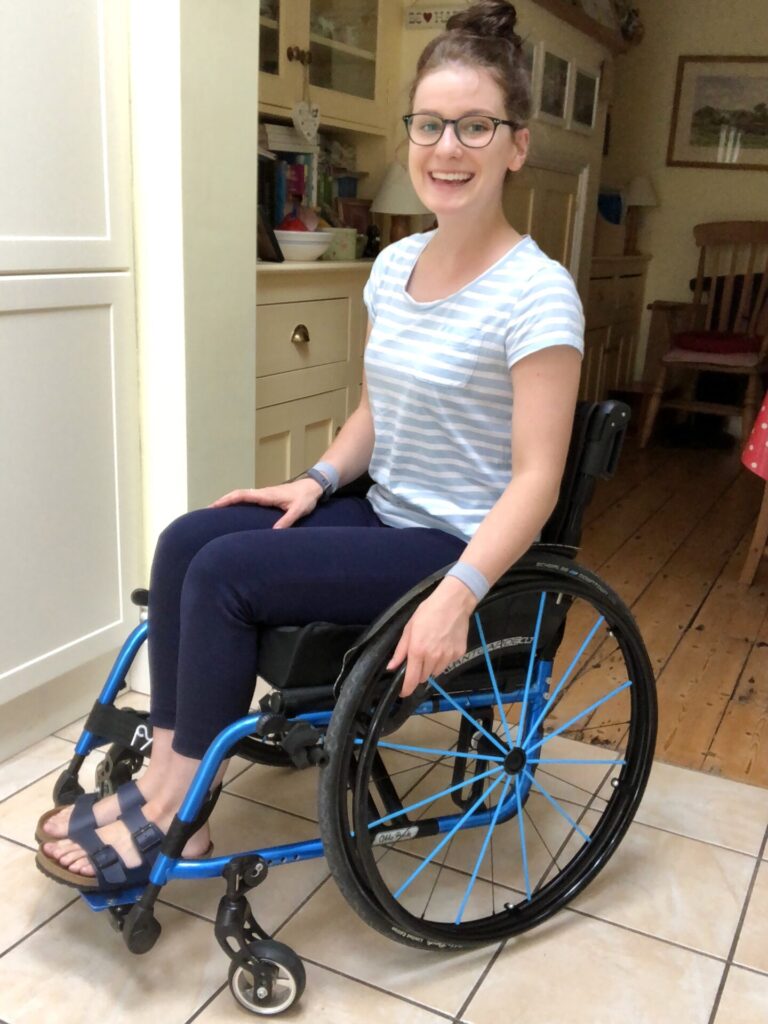Explore Our new shop

Folding wheelchair with a minimalist open frame design, similar to the appearance of a rigid frame chair. It folds in half using a cross brace mechanism, but the back does not fold down. The footrest is integrated into the frame rather than being two separate swing-away footrests. It features self-propelled, quick-release wheels, fold-down push handles (these were an optional extra), and carbon fibre mudguards. The seat and back are tension adjustable, with a Jay SoftCombi seat cushion. Available in many frame colours – mine is a bright electric blue.
Frame Benefits: The frame is very lightweight, and I loved how it had a minimalist open frame design, as many folding wheelchairs do not have that. The folding design of the frame means the chair can be easily stored away and fits through narrow doorways (when folded up).
Frame Drawbacks: The frame is longer from front to back than other chairs I have tried. The footplate part of the frame is set at an approximately 80-degree angle (I think), which sticks out more than chairs with footplates at a neatly compact 90-degree angle. This makes it harder to use in small spaces, and because the frame includes the footplate (which can’t be folded away or removed), it is hard to fit the chair into the back of small cars.
Wheels Benefits: The quick-release wheels are very useful; they pop off easily, making it easier to fit the chair into a car boot. I have mid-range Ottobock wheels that came with the chair. They are lighter than standard wheels, but not as light as Spinergy wheels. I also have Schwalbe Downtown tyres, which seem to be quite durable and good on a variety of types of ground. I opted to position the rear wheels quite far forward so that the centre of gravity is better balanced, making wheelies easier. I do not have anti-tippers on the chair for the same reason, but I think they could be fitted if you wanted them. Additionally, if you prefer a more stable chair and are not interested in doing wheelies, then the wheels can be moved further back to create a much less tippy position.
Wheel Drawbacks: None that I can think of.
Push Handle Benefits: I love that the push handles fold down, so I can keep them out of the way when I am self-propelling. This also prevents random strangers from suddenly pushing me because they think they’re “helping”!
Push Handle Drawbacks: I am quite a small person, so my chair is not very high, and the push handles are not height-adjustable. If someone pushes me for a prolonged period, bending down causes their back to hurt, so I would recommend height-adjustable push handles if you think you’ll be frequently pushed by someone else.
Seat Cushion Benefits: The Jay SoftCombi seat cushion is very comfortable, made of memory foam and has a contoured shape to position the pelvis correctly. It is quite firm, providing good postural support.
Seat Cushion Drawbacks: The firmness of the SoftCombi cushion may not suit everyone – I personally find it a little too firm for my liking. It is also very hot and sweaty to sit on in the summer, as the cover is polyester.
Carbon Fibre Mudguard Benefits: The mudguards are great – they have saved my clothes from getting wet and dirty in bad weather and also prevent them from getting caught in the wheels. They are not removable, but the carbon fibre makes them super lightweight.
Carbon Fibre Mudguard Drawbacks: None that I can think of.
Overall Impression: The Ottobock Avantgarde CLT is a great mid-range wheelchair, suitable for someone new to using a wheelchair who needs to figure out what works best for them. This chair is highly adaptable over time, with the front caster position, rear wheel position, backrest angle, and footplate height from the seat all being adjustable. If you’re an experienced wheelchair user or plan to be quite active in your chair, I would recommend getting a rigid frame instead of this one. This folding frame is less energy-efficient to propel due to the moving parts, and the folding mechanism also increases the weight of the chair.
I loved this chair when I first started using it as I was a new wheelchair user, but over time, it became less suitable for my lifestyle, so I switched to a rigid frame with a more active-user setup. My car is also small, and I had real trouble fitting this chair in it. Many people think that folding chairs are easier to transport, but that’s not necessarily the case – rigid chairs can typically have their wheels removed and the backrest folded, allowing them to sit on any spare seat in the car. Folding chairs can’t do this because of the cross-brace mechanism underneath, so they need to go in the boot. As I mentioned above, the Ottobock Avantgarde CLT has quite a long frame from front to back with no swing-away leg rests, which made fitting it in the boot of my small car very challenging!
SHARE PREVIEW